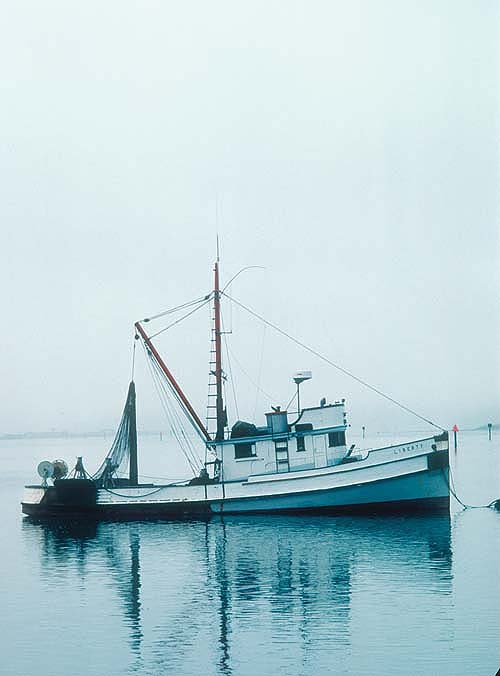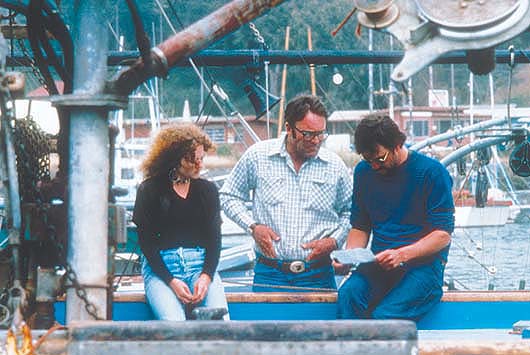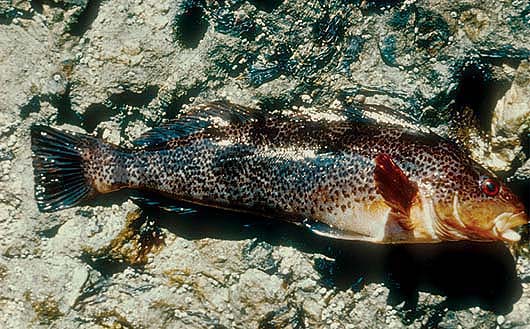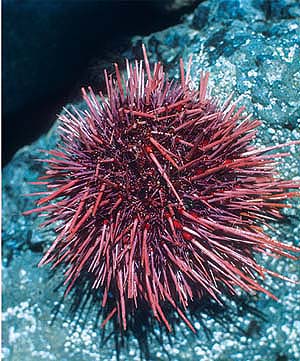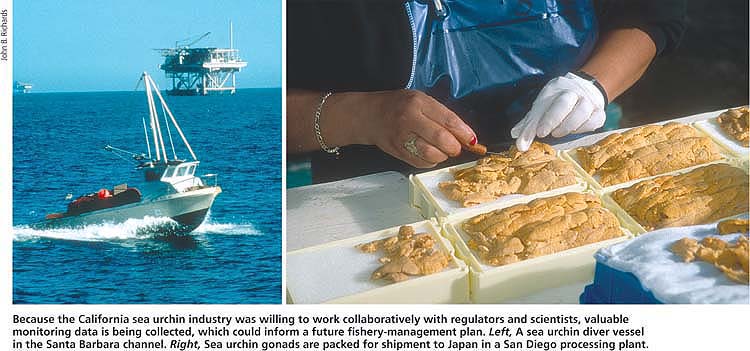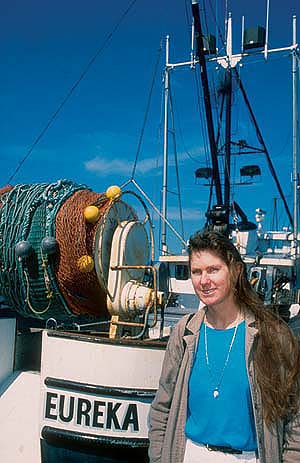All Issues
Conserving California fish … Extension approaches applied to contentious marine-fisheries management issues
Publication Information
California Agriculture 58(4):194-199. https://doi.org/10.3733/ca.v058n04p194
Published October 01, 2004
PDF | Citation | Permissions
Abstract
We describe three creative collaborations between the California Sea Grant Extension Program (SGEP), the California Department of Fish and Game, the fishing industry and university researchers to improve marine fisheries management in California. These collaborations involved difficult and long-standing issues at a time when many fisheries are declining. The cases studied highlight SGEP's involvement in (1) implementing California's comprehensive marine-life management legislation, (2) helping the sea urchin industry identify goals and techniques to achieve them, and (3) using extension methodologies to enhance socioeconomic research related to management of the Dungeness crab fishery. Critical components of SGEP methods were trust, independence and nonadvo-cacy, a science-based approach, and effective communication. These characteristics are seldom found together among diverse participants involved in contentious fisheries-management situations. We demonstrate how extension programs can partner with constituents and agencies to improve the management and research process; this approach can be applied to the broad range of natural-resource issues facing the state.
Full text
Marine fisheries nationally and in California have a long history of producing significant commercial and recreational benefits. Commercial fishing is the last significant industry where participants hunt and harvest wild organisms. Fisheries resources are common property, and with few exceptions participants do not have exclusive harvest rights. Fishermen are primarily small-scale, individual, owner-operators of vessels who compete intensely for a limited renewable resource in California's extremely variable marine environment.
With some Pacific fisheries in decline, marine management issues are often contentious. In Bodega Bay, an old trawler rests on its mooring.
Over the past 30 years, the fishing industry has evolved from the development and expansion phase to recent declines in production and participation. The industry is challenged by the closure of some fisheries and fishing locations, increased regulation and restrictive management mandated by federal and state laws, reallocation of fisheries resources to other users, and an increase in large areas set aside as marine reserves. Perceiving these threats to their livelihoods, the fiercely independent industry participants now tend to have adversarial or untrusting relationships with agencies and outside groups involved with fisheries management, making these issues increasingly contentious and difficult to resolve.
As the fishing community's needs changed, the focus of UC Cooperative Extension's Sea Grant Extension Program (SGEP) switched from increasing fishing production to emphasizing fisheries management, conservation, fuel efficiency, value-added products and the evaluation of techniques for reducing harvest capacity. Administered by UC, California Sea Grant sponsors research on marine-related issues and problems, and transfers that information via extension to industry, government and the public.
SGEP has built a reputation as a trusted, nonadvocacy source of research-based information and assistance to those involved in today's critical fishery-management issues. This capability gives SGEP a relative advantage in helping improve fisheries management in California.
This paper describes three different collaborative approaches involving SGEP, the California Department of Fish and Game (DFG) and the fishing industry: implementation of a comprehensive, new, state marine-life management law; development of science-based information for a plan to better manage the sea urchin fishery; and evaluation of management options for the Dungeness crab fishery. In all three, trust among participants and SGEP's nonadvocacy approach were key elements. The approaches used in these cases are directly applicable to other contentious natural-resource issues (such as wildlife management, forestry and land management) and high-conflict situations.
UC Cooperative Extension's Sea Grant Extension Program has long taken a lead role in finding collaborative solutions to difficult fisheries-management problems in California. Marine advisor emeritus Bruce Wyatt (center) consulted with a fishing couple about the Dungeness crab fishery.
California marine fisheries
Marine commercial fisheries have changed dramatically over the past 30 years. During the 1970s, expansion of fisheries, opening of new fisheries, technology transfer and increased production were emphasized in response to national policy initiatives. These initiatives were effective in creating high harvesting capacity (Weber 2002). Today, a top fisheries-management priority is reducing this harvesting capacity to a level that more closely matches sustainable catch levels.
Between 1981 and 1999, California's commercial fishing landings declined from 791.4 million pounds to 472.1 million pounds and in value (1999 dollars) from $475.7 million to $144.4 million (Thomson 2001). Much of this decline was due to the shift in tuna landings to less costly ports in American Samoa and Puerto Rico, as well as declines in the landings of rockfish, urchin, salmon, abalone and other species. At the same time, harvests of squid, lobster and sardines expanded. Thomson (2001) reported that expenditures by recreational marine anglers averaged $506.9 million in 1998 and 1999, but in general participation has declined in recent years.
Between 1981 and 1999, the number of commercial fishing vessels that land fish in California declined from 6,897 to 2,690 (Thomson 2001). Many of those remaining adopted new technologies (especially fish-finding electronics) to compete. In addition, fisheries such as those for salmon and sea urchin faced declining prices due to increased supplies and competition from aquaculture and other countries (Leet et al. 2001).
Marine Life Management Act of 1998
In response to growing concern among environmental groups, scientists, citizens, legislators and some fishing groups about declines in marine and estuarine fisheries, the California legislature passed the landmark Marine Life Management Act (MLMA) of 1998 (Weber and Heneman 2000). Key elements of the MLMA include:
-
Switching responsibility for marine fisheries management from the state legislature to the Fish and Game Commission.
-
Mandating a Status of Fisheries Report with annual updates.
-
Requiring DFG to develop fishery management plans (FMPs) and research protocols to fill information gaps.
-
Requiring scientific peer review of documents and a high level of constituent involvement.
Soon after the MLMA became law in 1999, the DFG realized that they did not possess all the scientific expertise and research-based information needed for its successful implementation. SGEP decided to become involved because we believed that extension techniques could be used to significantly improve the state's ability to manage its marine fisheries.
Training
With DFG funding, SGEP conducted training workshops for DFG Marine Region staff on managing near-shore fisheries and conducting collaborative research with constituents. SGEP brought in fisheries scientists, agency staff and commercial fishermen from around the country to share their experiences and provide near-shore case studies from Alaska, British Columbia, Washington, Oregon and Maine. The 2-day training workshop helped DFG staff form concepts for drafting the mandated, highly complex near-shore FMP and strengthened DFG staff collaboration with university scientists and other state-agency personnel. The near-shore FMP was adopted by the California Fish and Game Commission and implemented during the 2002-2003 fishing season.
The training on constituent involvement and collaboration was less successful. We failed to include examples of collaboration with recreational fisheries participants, which some DFG and external constituents perceived as a bias. DFG continues to struggle with constituent involvement, although they have recently initiated collaborative fish-stock monitoring programs with fishermen, divers and others.
Fisheries report
With DFG staff and more than 100 outside authors and reviewers, SGEP designed, edited, compiled and published the peer-reviewed California's Living Marine Resources: A Status Report (Leet et al. 2001), modeled after SGEP's California's Living Marine Resources and their Utilization book (Leet et al. 1992). This publication serves as the primary reference for managers, policymakers, journalists, students, industry and interested citizens about California's marine ecosystems, fisheries, aquaculture and other marine organisms. The Web version received approximately 25,000 hits during the first 16 months, with users often downloading individual sections.
Sea Grant advisors provided technical assistance and training to regulators on the peer-review provisions of the Marine Life Management Act of 1998. Under the state law, the kelp greenling, above, is managed under a complex fishery-management plan developed for near-shore fishery resources, which was implemented in the 2002-2003 season.
In the late 1980s, the California sea urchin industry imposed a landings tax on itself, raising more than $1 million for research and management activities. Sea Grant advisors facilitated statewide meetings to identify fishery goals.
Peer reviews
SGEP facilitated, designed and carried out independent, external, scientific, MLMA-mandated peer review of proposed FMPs for the white seabass, near-shore and squid fisheries, as well as the Abalone Recovery and Management Plan (Leet et al. in press). We submitted summaries of the review panels' primary findings to the DFG and Fish and Game Commission. DFG used detailed and technical reports from individual review-panel members to guide their revisions. Significant improvements were made to the plans based on the peer reviews and constituent comments. As of this date, the Fish and Game Commission has approved the white seabass, near-shore fisheries and abalone plans and is reviewing the final squid plan for possible adoption in late 2004.
We learned several key lessons from our involvement in the MLMA peer-review process. First, SGEP's independence in selecting and conducting science reviews is critical to avoid either the agency or constituents from trying to influence the outcome. Even a perception of outside influence makes the process difficult. In addition, DFG staff need to increase their understanding and effective use of scientific and constituent review of FMPs.
However, current and projected budget shortfalls for DFG are greatly slowing effective implementation of the MLMA. Nonetheless, SGEP continues to provide training to DFG and constituents, which will improve their capability to utilize outside scientific review and expertise successfully when resources are available to resume MLMA implementation.
The sea urchin fishery
The fishery for red sea urchin (Stron-gylocentrotus franciscanus) began in the early 1970s and has been one of the state's most valuable since the mid-1980s. Urchins are harvested by commercial divers for their gonads, which are marketed primarily in Japan. Annual landings peaked in 1988 at 52 million pounds, worth approximately $20 million to fishermen. From 1995 to 1999, annual landings averaged 17.04 million pounds worth $16.15 million, representing 4% of statewide commercial fishery landings and 10% of the revenue fishermen receive for their catch (ex-vessel value) (Thompson 2001). Intense fishing, unfavorable ocean conditions and difficult markets combined to reduce landings (Dewees 2003).
Recognizing the explosive growth in the fishery and the need for management, the sea urchin industry and DFG created the DFG Director's Sea Urchin Advisory Committee (DSUAC) in 1987, with funding from an industry-imposed landings tax. More than $1 million was raised for research, enhancement and management activities. Between 1987 and 1993 almost all of the current management system was developed collaboratively by the DSUAC and DFG.
By 1993, concern about the status of the urchin fishery motivated DFG to draft an FMP. This plan was not well received by industry or a jointly selected science review panel. Collaboration, communication and momentum waned after 1994, and in 2001 DSUAC was disbanded. However, the urchin industry continues to have a strong interest in collaboratively constructing a workable management plan to ensure a biologically sustainable and profitable fishery. The MLMA provides the structure for doing this.
Christopher Dewees, UC Davis marine fisheries specialist and a DSUAC member from 1987, was familiar with the difficult issues facing the fishery. In consultation with the industry and DFG, SGEP facilitated a series of meetings statewide, in August and September 2002, to help the industry identify and prioritize goals, the precursor to designing a new management plan.
SGEP facilitated three all-day meetings about fishery goals with 45 sea urchin divers and processors. DFG staff sat in as observers. The top goals identified included stock and fishery sustainability, and collaborative data collection and management with DFG. In addition, the industry supported the establishment of an effective industry organization to participate in DFG and commission meetings, organize participation in research and data collection, access fishery data, market product and improve the industry's public image.
Because the California sea urchin industry was willing to work collaboratively with regulators and scientists, valuable monitoring data is being collected, which could inform a future fishery-management plan. Left, A sea urchin diver vessel in the Santa Barbara channel. Right, Sea urchin gonads are packed for shipment to Japan in a San Diego processing plant.
To address the first two goals, the industry used funds remaining in the DSUAC landings-tax budget to hire a top shellfish ecologist (J. Prince, Murdock University, Australia) and a top fishery-stock assessment scientist (R. Hilborn, University of Washington). In 2003, Prince and Hilborn designed an approach for resource monitoring and stock assessment that the divers could participate in as part of their regular fishing activities. The consultants spent 3 weeks diving and meeting with urchin fishermen, DFG biologists and university scientists, and high levels of idea sharing and trust were developed among participants.
SGEP's role was to help arrange meetings in the various ports among participants, and plan and facilitate an industry-DFG workshop to finalize suggestions for the consultants. Late in 2003, Prince and Hilborn provided the resource-monitoring plan to industry for consideration. Data gathered by the industry could become a vital part of a future sea urchin FMP and potentially a good collaborative model for other fisheries.
The third goal of establishing an effective industry organization is progressing. Legislation was passed allowing the industry to form a state commodity board, which will assess members to fund research, management and promotional activities (similar to an agricultural commodity group). An industry-wide referendum on establishing this sea urchin commission passed overwhelmingly in late 2003.
We learned several key lessons from our work with the sea urchin industry. First, fishery participants trusted us enough to share their goals and then to accurately report that information to the rest of the industry, agency staff and others. Agency staff trusted us to work independently with fishery participants on management-related issues. Second, extension staff's ability to organize and facilitate collaborative meetings on complex and controversial issues was a key attribute.
Finally, these attempts at collaborative research and management would not have been possible without the willingness and ability of the urchin industry to tax itself and initiate the activity. Sustaining this effort will likely depend on the industry's willingness to fund collaborative studies. Increased profitability and the ability to sustain the tax assessment will be critical.
Dungeness crab fishery research
The fishery for Dungeness crab (Cancer magister) is conducted with baited traps from central California through Alaska. Since 1990 it has been the most valuable single-species fishery for the Pacific states of Washington, Oregon and California, according to the PacFin database of the Pacific States Marine Fisheries Commission. Crab abundance varies widely each year, and there is some evidence for cycles in abundance. Despite this high level of variability, most fishery participants and managers generally agree that the regulations for season, size, trap design and male-only harvest are protecting the resource from over-harvesting ( see page 186 ).
However, the Dungeness crab fishery in California is characterized by its increasing intensity. California trap numbers have increased from an average of 29,115 during the 1971-1972 through 1975-1976 fishing seasons to approximately 175,000 during the 2000-2001 season. Currently, fishermen land approximately 80% of the legal-sized crabs during the first month (December) of the season compared with crab landings being spread out over the 7-month season before 1980 (Hankin and Warner 2001). The race for crabs results in crowding, fishing in unsafe conditions with loss of vessels and lives, conflicts between large and small vessels, oversupply of product early in the season, and intense price disputes. These conflicts have intensified in recent years as fishermen in other declining fisheries have increased their participation in crabbing.
The industry recognizes these problems. In 1997, they implemented a license moratorium to prevent entry into the fishery. However, fishing pressure and conflict continues to intensify. Fishery participants have worked unsuccessfully to address these problems for the past decade, primarily by trying to set limits on the number of traps each vessel can use.
In 2001, California Sea Grant funded faculty from Humboldt State University and the Sea Grant/Cooperative Extension marine fisheries specialist to conduct a 3-year study on the fishery. One major goal was to identify feasible alternative management techniques to increase the fishery's net economic benefit. Involvement of the extension component was essential to secure industry participation on a project investigating such contentious issues.
This collaborative faculty-Cooperative Extension effort started with a worldwide review of management approaches used to address similar problems in other trap fisheries targeting crustaceans. Focus-group meetings were conducted in key ports to obtain industry input and involvement in comprehensive surveys of crab fishermen and processors. Later, the researchers hosted port meetings to present and discuss survey results with crab permit owners, testified before the state legislature's fisheries and aquaculture committee, and initiated publication of the processing-sector analysis (Hackett et al. 2003) and fishermen survey results. ( see page 186 , 190 )
The review of management methods used around the world in similar fisheries gave fishermen the opportunity to think about and discuss alternatives to the status quo or the much-debated trap-limit approach, and we were able to measure fishermen's perceptions of those alternatives in the survey. While trap limits were the preferred alternative, we pointed out that they do not necessarily reduce the total number of traps if the maximum limit is set too high (Acheson 2001).
The survey had a 40% response rate; by comparing respondents with the industry-wide demographics, we determined that our sample was representative of the entire fleet. Generally, the highest response rates were from ports where we conducted focus-group meetings before the mail survey. We believe that increased awareness of the project, participation in survey design and trust built up by the focus-group meetings improved the questionnaire return rate.
California Sea Grant advisors have learned that they must maintain their independence, not be perceived as advocates for a particular side and pursue science-based solutions. Susan McBride, a Eureka-based marine advisor, leads collaborative research projects with commercial fishermen.
Fishery participants, agency staff and policymakers can use the data collected on fishery activity, economics, demographics and perceptions of management approaches for negotiations on future management changes. Legislation is likely that may include proposals for some form of trap limits, zonal management and daylight-only fishing. Washington state has already implemented trap limits and Oregon is considering them.
Two key lessons from this case are that collaborative research by extension and research faculty on contentious human dimensions of resource issues is significantly enhanced by the knowledge, trust and nonadvocacy approaches that extension faculty supply; and involving industry participants in project design appears to increase the relevance and credibility of the results among participants.
Contentious management issues
These three cases involve highly contentious marine-fisheries management issues in which extension has been able to play a key role in the search for potential solutions. The MLMA implementation case covers the state's fishery management system in general, while the other two examples involve specific, valuable, individual fisheries. A common thread across all three was a high level of mistrust of the management agency among constituents.
We took different approaches in each situation. The MLMA mandated that scientists review the science in management plans. DFG, industry and other constituents were relatively inexperienced with outside review, so we decided to include DFG training as part of our approach. We are also compiling recommended peer-review procedures for the DFG to use with future FMPs. We hope that in the long term, these actions will increase the agency's ability to incorporate outside research-based information and review into their resource management planning.
Our decision to use facilitation as the primary method with the sea urchin industry was based on our long-term involvement with the industry. We observed that divers, processors and DFG needed to identify specific goals for an FMP. Once these goals were identified, it expedited the formation of a Sea Urchin Commission and the development of collaborative, industry-based resource assessment protocols. Our primary goal is to strengthen the organizational and research capabilities of the sea urchin industry, leading to improved integration with DFG and academics. We hope that a collaboratively developed FMP is the end-result.
Our reason for choosing a research approach with the Dungeness crab industry was based on the need for independently collected socioeconomic data and opinions on management alternatives, to inform the industry's discussions of proposed management changes. Debate between large and small vessel owners is often highly contentious, and this information will be important to the design and discussion of any future legislation.
In these three marine fisheries cases, Cooperative Extension's Sea Grant staff had four relative advantages. These characteristics illustrate the unique role that extension can play in contentious natural-resource issues. Industry, agencies and nongovernmental organizations often lack some of these attributes. The lessons from these three cases are certainly applicable in nonmarine natural-resource settings as well as agricultural and human resources problems.
Independence and nonadvocacy
If you advocate on an issue, or are even just perceived as an advocate for one specific solution or one stakeholder group, you quickly lose credibility with the other involved groups. This was particularly critical with the MLMA peer-review process, where we had to remain stridently independent to avoid the perception of being aligned with the management agency. The same was true with our crab fishery research. Both the reality and perception of being an “honest broker” is key to success.
Trust
This is earned by sustained honesty and follow-through on promises. In these three cases, all stakeholders needed to trust us to conduct independent peer reviews, protect confidentiality, not advocate and deliver promised products.
Effective communication
This is needed to avoid misunderstanding, promote an open exchange of ideas, assure inclusiveness and increase participation. Extension staff often has an excellent understanding of formal and informal communication channels, and we used this to enhance project success.
Science-based approach
Bringing in outside scientists to review management plans independent of the agency and stakeholders has advanced both the quality and acceptance of the science in California's FMPs. In the sea urchin case, collaboratively developing stock-assessment research protocols is likely to lead to increased data collection and reduced controversy about the validity of this data. The crab fishery research example demonstrates that partnerships of extension staff and campus faculty in human-dimensions research can improve the quality, relevance and acceptance of the results.



